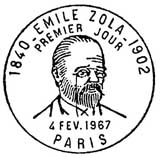TIMBRES DE FRANCE
Ex : 50 c
Ex : 456
Ex : Appel du 18 juin
Ex : 1900
Ex : Femme
mini 4 lettres
Création du site : Juillet 2005
Nombre de visiteurs : 40.022.008
Nombre de pages : 113.014.222
Dernière mise à jour 03-06-2025
Nombre de visiteurs : 40.022.008
Nombre de pages : 113.014.222
Dernière mise à jour 03-06-2025
Cette bannière est une publicité le site n'a aucune boutique de vente
Les informations sur ce timbre ont été mises à jour le : 24/10/2024

Emile Zola (1840-1902) écrivain et journaliste français
Timbre : Courant / moderne
Voir tous les timbres courants de l'année 1967
Listage des timbres de l'année 1967




Cachet premier jour


Premier jour : Oblitération 1er jour à Paris le 4 février 1967
Vente générale : 6 février 1967
Retrait de la vente : 9 septembre 1967
Valeur faciale : 30 c + 10 c
Graveur : Claude Durrens
Dessinateur : Claude Durrens
Département concerné par ce timbre : Paris
Dentelure : Dentelé 13
Couleur : noir bleu et vert
Mode d'impression : Taille douce
Format du timbre : 26 x 40 mm ( image 21,45 x 36 mm bords externes des filets)
Quantité émis : 3.580.000
Présentation : Feuille de 50 timbres
Bande phosphore : Sans
Catalogue Yvert et Tellier France : N° 1511
Catalogue Spink / Maury France : N° 1511
Catalogue Michel : N° FR 1572
Catalogue Scott : N° FR B404
Valeur marchande timbre neuf avec gomme intacte: 0,09 €
Valeur marchande timbre oblitéré : 0,08 €
La valeur marchande représente une valeur de base du timbre pour la vente ou l'échange
Thématique catégorie : Poètes, écrivains, philosophes, historiens
Informations sur le sujet du timbre
Emile Zola
né à Paris le 02/04/1840 , mort à Paris le 29/09/1902Il publie en 1865 son premier roman, la Confession de Claude, en 1867, il publie son premier roman naturaliste : Thérèse Raquin. L'oeuvre, qui raconte un meurtre sordide et la déchéance des personnages rongés par la mauvaise conscience, fait un scandale dans la presse. Zola s'appuie sur des considérations scientifiques en mettant en exergue la filiation de tares au sein de cette famille. Zola souhaite donner à la littérature une portée scientifique et théorise dans ce sens le « roman expérimental », dont l'objectif est d'observer un personnage...lire la suite
Emile Zola
born in Paris on 02/04/1840, died in Paris on 29/09/1902He published his first novel, the Confession of Claude, in 1865, he published his first naturalist novel: Thérèse Raquin. The work, which tells of a sordid murder and the degradation of characters plagued by bad conscience, makes a scandal in the press. Zola relies on scientific considerations by highlighting the filiation of tares within this family. Zola wishes to give literature a scientific and theoretical scope in this sense the «experimental novel», whose objective is to observe a character in a multitude of very different situations.
Emile Zola’s publications became, despite the scandals, real commercial and literary successes, especially from l'Assommoir. In 1880, Zola published Nana, a story of the rise and fall of a prostitute. Once again, success was at the height of scandal. Five years later, Germinal plunges into the world of miners and places the working class people at the centre of the plot.
On 13 January 1898 he published an open letter entitled «I accuse...!» This is the real point of the Dreyfus affair. On 29 September 1902, he was asphyxiated at home because of a blocked chimney. Anti-Dreyfusards are suspected but the investigation does not lead to conclusive results. His funeral at the Montmartre cemetery sees many writers and anonymous, among whom minors especially from the north pay tribute to the author of Germinal.
Source : various Internet documents including Wikipedia
